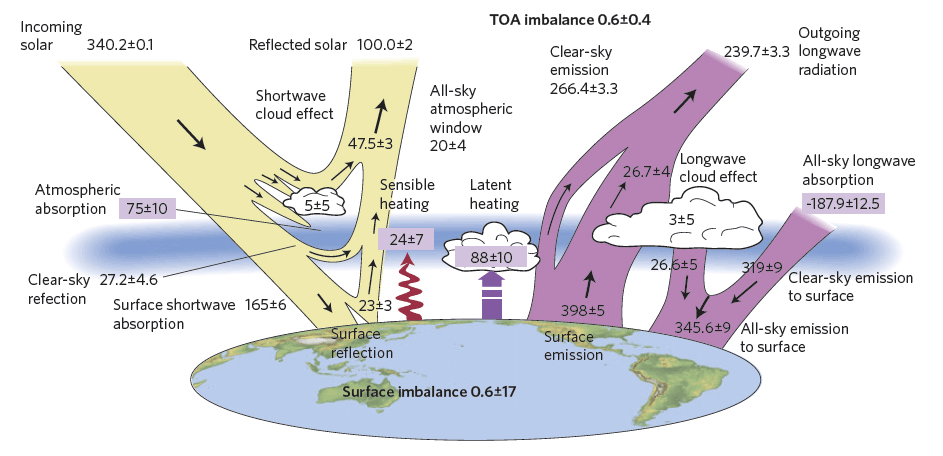While the gang ponders the impact of Merchants of Doubt, the movie, I have drifted back to my questions about "global" latent heat flux. There is considerable differences between the different latent heat flux products. In the beginning, back in the day of the younger James Hansen, data was crude at best. Kiehl and Trenberth produced a series of Earth Energy Budgets that attempted to get all the pertinent information down in an easy to read format.
If you have followed my ramblings you know that I discovered an error in these budgets along with a number of others, but it was Stephens et al. that final published a revised budget a couple of years ago.
This budget was discussed on Climate Etc. back in 2012. Stephens et al. have latent at 88 Wm-2 +/-10 Wm-2 with K&T likely being the minus 10 and Chou et al likely the plus 10. The other major difference is the atmospheric window where Stephens et al have about 20 +/- 4 and K&T in their latest are still using the 40 Wm-2 with no indication of uncertainty.
This post was prompted by Monckton of Benchley mentioning the Planck Feedback parameter he derived using the K&T budget. That was based on the paper, On the confusion of Planck feedback parameters, by Kyoji Kimoto. At the time I mentioned that Monckton and Kimoto were off because they used the inaccurate K&T budget, but that was prior to a real scientist publishing a revised budget.
Climate science appears to be finally catching up, but various irreducibly simple models never finish connecting the dots. Tropical water vapor, clouds and convection are the most likely candidates for the regulating feedback. Around 98 Wm-2 of latent you peg the negative feedback portion of the regulating feedback triggering deep convection. If you initially assume that latent is 78 Wm-2, one of the initial estimates used by K&T, you have a large range of positive feedback from 78 to 98 or 20 Wm-2 which is about half of the atmospheric window assumed by K&T. Since an absolute temperature has been a wild assed guess at best along with latent and convective energy flux, the room for warming has always been over estimated.
Andy Lacis on Climate Ect. mentioned they project a 28% increase in atmospheric water vapor which would roughly be equivalent to a 28% increase in latent heat flux. A 28% increase from 78 Wm-2 would be 99.8 Wm-2 which we are roughly at now if Chou et al had an accurate estimate back in 2004.
The followers of the Merchant of Doubt drivel seem to believe anytime someone mentions uncertainty they are clouding the issue, but when all uncertainties tend to lead to the highest possible estimate, that is a simple sign of bias. You do not have to be a rocket or atmospheric scientist to be aware of sensitivity of error. In climate science the old guard are doggedly defending estimates based on extremely poor data while ignoring prompting by peers that they are off. With accurate latent estimates Earth's Energy Budget is at the elusive Planck Feedback limit.
That does not mean there is not going to be some residual warming at the poles, but most of that will likely be in winter related to energy release mechanisms like Sudden Stratospheric Warming (SSW) and Arctic Winter Warming (AWW) related to increased pole ward "wall" energy flux.
The key to "proving" as in providing convincing evidence, are more accurate estimates of latent heat flux and convective response. The newest Stephens et al paper, also discussed on Climate Etc. appears to have part of that evidence.
It indicates that the northern hemisphere is releasing energy while more is being provided by the southern hemisphere via ocean currents. Unfortunately, they may not have the estimate of northern hemisphere heat loss to space associated with SSW and AWW events correct. That may require a more creative non-linear approach likely Fluctuation Dissipation Analysis, but really could be estimated with surface energy anomaly and high northern latitude ocean heat uptake. Basically, northern high latitude SST has increased while ocean heat uptake has flat lined above 50 north. That difference after considering uncertainty, should be heat loss not easily measured by satellite at the pole. That loss can be on the order of 10^22 Joules in a single season.
The northern hemisphere heat loss may or may not trigger a negative AMO phase, which would make the shift obvious or it may just continue destabilizing the north polar jet/vortex until some glacial increase begins to store the energy. Greenland is beginning to show signs of accumulation, but that may take a decade to be "noticed" given the current state of climate science. Then again that loss could trigger an ice mass loss event, such is long term climate.
In any case, perhaps the current buzz will inspire some to revisit the much maligned, On the Confusion of Planck Feedback Parameters with more up to date observations.



No comments:
Post a Comment